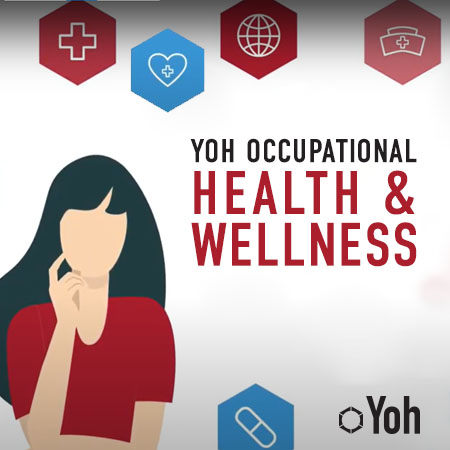- Specialty Practices
- Healthcare
- Occupational and Employee Health
Occupational & Employee Health
40+ years of nationwide healthcare sector expertise!
CUSTOMIZED TALENT SOLUTIONS TO FOSTER HEATHIER WORKPLACES
For decades, Yoh Healthcare has specialized in designing health and wellness programs tailored to businesses of every shape and size. We recognize that sustaining productivity hinges on retaining a healthy workforce. That’s why we count on a team of expert professionals, along with advanced technology, to customize a unique occupational health offering for your organization. Find out what Yoh Healthcare can do for you!
ROLES IN OUR SWEET SPOT
- Registered and Licensed Vocational Nurse
- Nurse Practitioner (NP) & Physician Assistant (PA)
- Medical Assistant & X-Ray Technician
- Supervisor/Health Center Manager
- Physical Therapist/Athletic Trainer
- Nutritionist
- Phlebotomist
RANGE OF SERVICES PROVIDED
- Healthcare screenings
- Wellness workshops
- Temperature screenings
- Personal protective equipment (PPE) fit testing
- Rapid health exams & wellness tests
- Annual flu shots & immunizations
- Disease prevention programs
- Stress management & counseling
- Disaster & emergency preparedness planning
PHI SECURITY & HIPAA-COMPLIANCE
Yoh Healthcare prioritizes Security and Privacy, especially concerning consultants engaged in projects with access to Protected Health Information (PHI). To uphold integrity and minimize exposure risks, Yoh has implemented:
- Compliance (HIPAA, OSHA, License Verification)
- Laptop Encryption Software
- Risk Assessment Procedures
WHY YOH HEALTHCARE?
DEEP SUBJECT-MATTER EXPERTISE
Yoh’s teams of Healthcare experts are deeply rooted in the sector and known for both their market knowledge and the caliber of their networks. They’re equipped to shape your talent strategies and delivery within the rapidly evolving Healthcare landscape.
A CUSTOMIZED APPROACH
Because every client is unique, we take a personalized and consultative approach to each one. Yoh invests ample time in understanding your pain points, hiring expectations, technical requirements, and company culture to present a fully customized solution that suits you best.
Recruiting solutions that flex with your business.
Need to scale fast with the right talent? Yoh connects you to specialized professionals who hit the ground running, whether you need short-term support, permanent hires, or full project teams.


/Specialty%20Practices%20Stock/Covid%20clinic%201.jpg)

